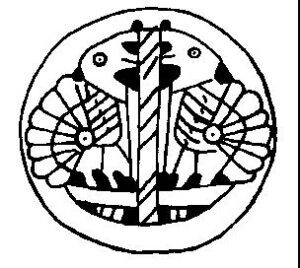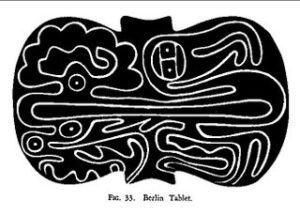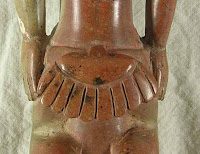Ancient Objects and Sacred Realms: Interpretations of Mississippian Iconography is a new book edited by Kent Reilly and James Garber and published by the University of Texas Press. It includes some remarkable new insights on the cultures of the Mississippian period, which we refer to as the Late Prehistoric period here in Ohio. Much of the book is about using historic and recent American Indian stories as guides to understanding the symbolism of what the authors refer to as the Mississippian Ideological Interaction Sphere (what scholars used to call the Southeastern Ceremonial Complex, or “Southern Cult”). Although most of the book focuses on the art of the great Mississippian centers of the southeastern United States, such as Moundville, Etowah, and Spiro, some of the conclusions relate directly to Ohio’s ancient cultures.
For example, there is a chapter by George Lankford on the Great Serpent in Eastern North America that includes a discussion of Ohio’s Serpent Mound. It is interesting that many of the artistic motifs used in the Mississippian Ideological Interaction Sphere seem to have precursors in the art of Ohio’s Adena and Hopewell cultures. This isn’t a terribly new observation. William Webb and Ray Baby devoted a chapter of their book The Adena People, No. 2, to a consideration of relationships between the “Adena-Hopewell” and the “Southern Cult.”
A new example that occurred to me while reading Reilly and Garber’s book is the fan-tail of a bird depicted on a particular style of shell gorget from the Hixon site in Tennessee. Traditionally, the bird has been interpreted as a turkey because of this flaring tail. George Lankford, however, argues that the feather fan is not meant to be a naturalistic representation of a particular bird’s tail. Instead, he argues that it is an “iconographic pun,” or a symbol, that was meant to convey some special meaning about the nature of the bird as well as human dancers who are shown holding similarly shaped feather fans in other Mississippian Ideological Interaction Sphere designs.

I think an earlier version of this same feather fan is depicted on birds carved onto some Adena tablets, such as the Berlin Tablet. Moreover, a very similar feather fan is worn by the human figure on the famous Adena Pipe. In wearing this feather bustle, he may have been taking on the powers associated with this feathered spirit of the Above World. The visual metaphor must have been as obvious to ancient American Indians as an image of a woman wearing only a fig leaf and holding an apple would be today to those of us steeped in the Judeo-Christian tradition.

Although Lankford acknowledges the iconographic “subtext” of this feather fan “cannot at present be read,” it is an important advance in our understanding of this ancient art to recognize it as a symbol with a special and particular significance. It’s also interesting to see the presence of this symbol in art ranging in age from as long ago as 800 BC to as recent as AD 1500.
